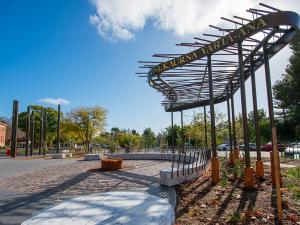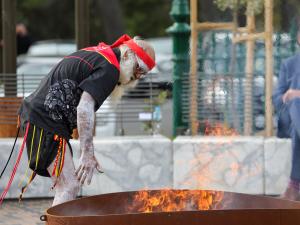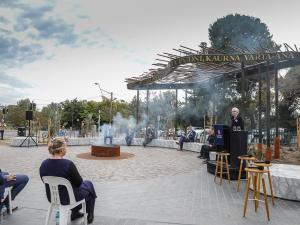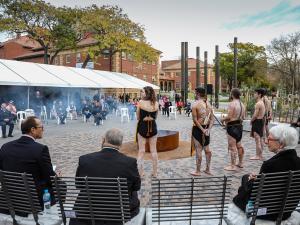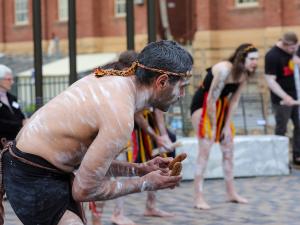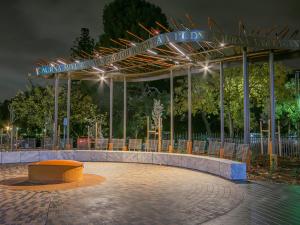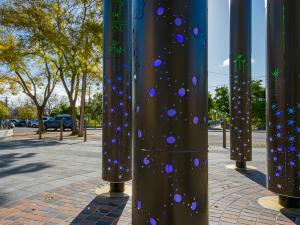New Learning Circle celebrates Kaurna culture on campus

Kaurna elder Uncle Fred Agius at the Wangu Poles, part of the redevelopment of the Kaurna Learning Circle, University of Adelaide. Uncle Fred led a smoking ceremony for the official launch of the Kaurna Learning Circle.
Photo by Russell Millard.
The University of Adelaide recognises and celebrates the Kaurna Aboriginal people and their deep connection to the Adelaide Plains, with the opening of the University’s new Kaurna Learning Circle.
Officially opened yesterday by the University and Kaurna elders, the Kaurna Learning Circle is an open-air meeting place and ceremonial space to be used by all.
Created as a collaborative project between the University’s Wirltu Yarlu Aboriginal Education and Kaurna cultural advisers, the Kaurna Learning Circle is the new landmark of the northern (riverside) entrance to the University’s North Terrace campus.
The outdoor venue includes a steel fire pit for ceremonial use, and a steel structure inscribed with a welcome to country: “Kaurna miyruna wangkanthi marni naa pudni, Kaurna yarta-ana” (“Kaurna people say good you all came to Kaurna country”).
The immediate northern entrance to campus also features the “Wangu Poles”, striking new artwork designed by talented Kaurna and Ngarrindjeri artist Paul Herzich. The seven poles, ranging in height from 6-8 metres, contain references to Kaurna dreaming stories, ancient ceremonial practices, and traditional life along the nearby Karrawirra Pari (River Torrens).
Comments from Uncle Rod O’Brien, Kaurna Elder and University Cultural Adviser:
“This new addition to the North Terrace campus is representative of something much older than any of us, our University or even the city of Adelaide. It connects us to the history of this land and the physical, cultural and spiritual importance of the Karrawirra Pari (River Torrens).
“As a Kaurna man I am very proud of my culture and language, and to see it acknowledged in this way is very special. The Kaurna Learning Circle is a place for reflection and discussion to strengthen our cultural knowledge, and to help others understand; I hope that it encourages more people to learn about our culture and history.
“I thank the University of Adelaide and the Kaurna advisers involved for their commitment to our people, to place, and to our cultural heritage.”
“As a Kaurna man I am very proud of my culture and language, and to see it acknowledged in this way is very special.”Uncle Rod O'Brien, Kaurna elder
Comments from Professor Mike Brooks, Acting Vice-Chancellor:
“The Kaurna people are the traditional custodians of the ancestral lands on which we gather every day for learning and teaching here at the University of Adelaide. The new Kaurna Learning Circle is designed to showcase those connections to our University and to celebrate Kaurna culture and places of learning.
“We have created a beautiful meeting place and ceremonial space to be used by all, long into the future.
“We are very proud that the Kaurna Learning Circle now forms part of the main northern entrance to our campus. This project has been developed as part of the University’s Reconciliation Action Plan, Yangadlitya (“For the Future”), which has highlighted the need for spaces to promote Indigenous culture.”

Kaurna elder Uncle Fred Agius leads a smoking ceremony using the ceremonial fire pit at the Kaurna Learning Circle, University of Adelaide.
Photo by Russell Millard.
Comments from Professor Shane Hearn, Pro Vice-Chancellor (Indigenous Engagement):
“Concentric circles in Aboriginal world view represent meeting place or ceremonial site. The circle is an important part of First Nations culture. It has been used by our peoples for centuries to learn from, build respectful relationships, and to preserve and pass on our cultural knowledge.
“This location will be part of teaching and learning, students’ understanding of First Nations knowledge, or even using it to take ‘me time’ and reflect. This space is for students and staff and community.
“The entirety of the new riverside entrance to campus, Karrawirra Parinangku (“From the Red Gum Forest River”), is now a physical dedication to the Kaurna people, and that is a great statement from the University of our commitment to fostering Aboriginal and Torres Strait Islander empowerment and self-determination.
“We have been delighted with the contributions made by Kaurna elders, cultural advisers and artists towards this major new space on campus, and I thank them for their dedication to this important project.”
The Kaurna Learning Circle is a key development in the University’s Public Realm project, which has just been awarded the Australian Institute of Landscape Architects (AILA) Award of Excellence for Urban Design.
Details about the Kaurna Learning Circle and surrounds
Kaurna Learning Circle
The Kaurna Learning Circle is a meeting place for ceremony, cultural exchanges and learning. The earthy brick paving contains a welcome in Kaurna language, "Marni naa pudni tirka kurruru-ana" (“good you all come to learning circle”). The circle contains a corten steel fire pit for ceremonial use, with the pattern of the Karrawirra pari (River Torrens) engraved. Stone seating is provided along one side of the Kaurna Learning Circle, with back rests to accommodate elders and senior representatives for cultural events. A steel shade structure partly covers the Learning Circle and is inscribed with a welcome to country, "Kaurna miyruna wangkanthi marni naa pudni, Kaurna yarta-ana" (“Kaurna people say good you all come to Kaurna country”). The design of the shade structure is based on the water and driftwood in the river. The structure contains integrated lighting, Wi-Fi and power for everyday use and events.
Wangu Poles
This art installation was designed by Kaurna and Ngarrindjeri artist Paul Herzich and consists of wangu (seven) large aluminium poles, laser cut with thousands of hand-drawn circles to tell an ancient Kaurna story of the relationship between the Wardlipari (the Milky Way) and the Karrawirra Pari (River Torrens). For thousands of years the Kaurna people have used the Karrawirra Pari to sustain their way of life. This artwork embodies traditional ritual knowledge of the Kaurna community. The poles create a new entrance statement for the northern entrance to campus and can be seen from the other side of the river, and at the top of the University’s red brick stairs, day and night.
Reconciliation Garden
Behind the Kaurna Learning Circle is a new garden with circular stone seating discs, compacted sand and garden beds with trees and shrubs from Kaurna country.
Spriggina floundersi
To the west of the Kaurna Learning Circle is another new sculptural installation, Spriggina floundersi, by local artist Silvio Apponyi. The sculpture depicts one of earth’s earliest known animals on earth. The genus named in honour of Reginald Sprigg, geologist and University of Adelaide graduate, who discovered the fossil remains in the Flinders Rangers in 1946. This sculpture was donated to the University through the Australian Government’s Cultural Gifts Program by The Hon. Tom Gray QC.
Media Contact:
David Ellis, Deputy Director, Media and Corporate Relations, The University of Adelaide
Mobile: +61 (0)421 612 762, media@adelaide.edu.au

